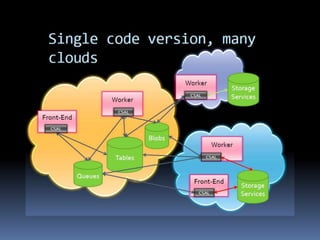CSAL
- 2. • Simply stated: Cloud = Internet • So..Cloud Computing = Internet based computing • More precisely, Cloud computing is: ▫ using information technology as a service. ▫ having services that are available over a network. ▫ using encapsulated services that have anAPI. ▫ adding to the efficiency for deploying applications. ▫ billing by consumption
- 3. On-demand self-service Broad network access Resource pooling Location independence Rapid elasticity Measured service
- 4. Cloud Software as a Service (SaaS) Use provider’s applications over a network Example: Facebook, SalesForce.com, Gmail Cloud Platform as a Service (PaaS) Deploy customer-created applications to a cloud Give me nice API and take care of the implementation Example: Google App Engine , Microsoft Azure Cloud Infrastructure as a Service (IaaS) Rent processing, storage, network capacity, and other fundamental computing resources 3Tier, Amazon EC2, Rackspace, GoGRID
- 5. Cloud computing often leverages: Massive scale Homogeneity Virtualization Resilient computing Low cost software Geographic distribution Service orientation Advanced security technologies
- 6. 4 Cloud Deployment Models Private cloud enterprise owned or leased Community cloud shared infrastructure for specific community Public cloud Sold to the public, mega-scale infrastructure Hybrid cloud composition of two or more clouds
- 7. Based upon original chart created by Alex Dowbor - http://ornot.wordpress.com Deployment Models Service Models Essential Characteristics Common Characteristics Software as a Service (SaaS) Platform as a Service (PaaS) Infrastructure as a Service (IaaS) Resource Pooling Broad Network Access Rapid Elasticity Measured Service On Demand Self-Service Low Cost Software Virtualization ServiceOrientation Advanced Security
- 8. v · d · eCloud computing Clients Browsers · Devices (Netbooks ·Tablets · Smartphones) · Operating Systems (Android · iOS · Windows Phone 7 · Linux) Applications Google Apps · Microsoft Online · NetSuite · Salesforce Platforms App Engine · Azure · EngineYard · Force.com · Heroku · MTurk · RightScale · S3 · SimpleDB · SQS Infrastructure EC2 · Eucalyptus · FlexiScale · GoGrid · Nimbus · Rackspace Cloud ·VPC Technologie s Networking · Security · Datacenters · Cloud storage · Internet · Structured storage ·Virtualization ·Web Services ·Virtual Appliance
- 9. Amazon Web Services Elastic Compute Cloud (EC2) Rent computing resources by the hour Basic unit of accounting = instance-hour Additional costs for bandwidth Simple Storage Service (S3) Persistent storage Charge by the GB/month Additional costs for bandwidth
- 10. Microsoft Azure Services Source: Microsoft Presentation, A Lap Around Windows Azure, Manuvir Das
- 11. HOW STORAGE OF DATA IS DONE?
- 12. Windows Azure Applications, Storage, and Roles Cloud Storage (blob, table, queue) Web Role LB n Worker Role m
- 17. CSAL Namespaces One namespace for each abstraction type Metadata only for containers Service endpoint, identifier, user credentials Each abstraction has an independent metadata store • Metadata cachingContainer ops are not very common • If data is stale, simply re-fetch and retry






















